For a light and refreshing meal, try my cold Shirataki Noodles with Honey Sesame Dressing. You can top the noodles with shredded egg crepe, chicken, and cucumber. It’s a perfect guilt-free summer noodle that is low in calories. It’s gluten-free, too!
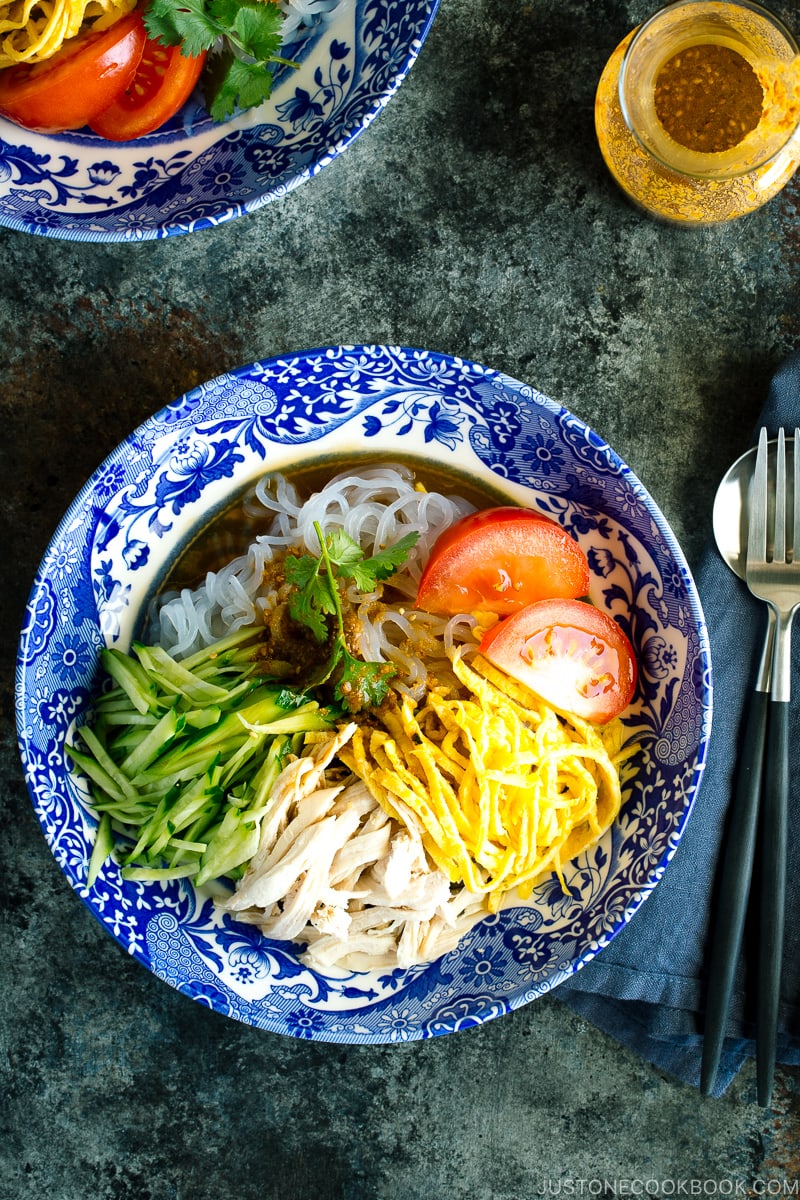
My family and I spend our summers in Japan with my family. In case you weren’t aware, the heat during Japanese summers are so brutal; it’s super hot and humid. We lose appetite and become reluctant to cook in the hot kitchen. If you experience similar summer weather, or if you want to eat something light to maintain your figure in the summertime…. this chilled Honey Sesame Shirataki Noodles is a perfect idea for your summer meal!
What is Shirataki Noodles?
Shirataki Noodles, or we simply call Shirataki (しらたき) in Japan, are thin, translucent, gelatinous noodles made from a type of fiber that comes from the root of the konnyaku (konjac yam plant).
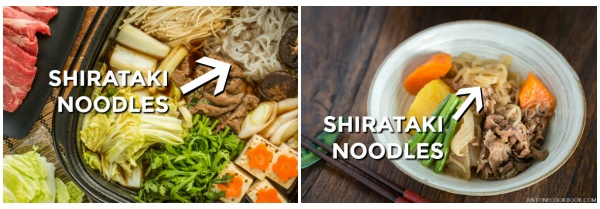
This Japanese ingredient has been around for years and is used in traditional Japanese dishes such as Sukiyaki, Nikujaga, and all kinds of hot pot dishes.
You can find shirataki noodles near tofu in the refrigerator section of Japanese grocery stores or Asian grocery stores.
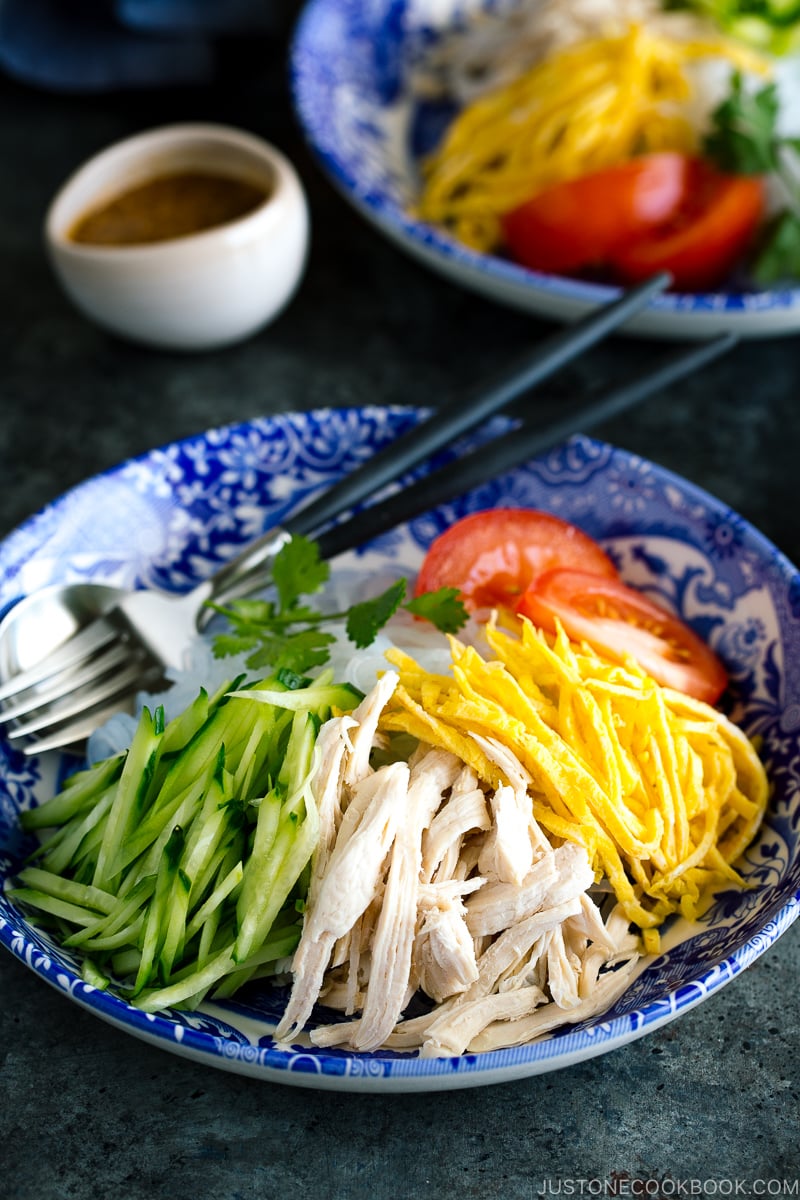
Shirataki Noodles as A New Healthy Ingredient
Shirataki has been eaten since the Edo period (1600) in Japan; however, it was never viewed as a “noodle substitute” or “diet food” until recently. As shirataki noodles are made of yam noodles, they have only a few calories per serving. Here are some facts:
- Contains about 97% water and 3% glucomannan fiber (from the konjac plant)
- Very low in calories
- Contain no digestible carbs
- Very filling (“expands” in the stomach as they absorb moisture)
Flavor-wise, shirataki noodles almost have no taste so it’s great for absorbing flavors from the sauce or soup they are soaked and cooked in. And texture-wise, they are quite slippery, and slightly more difficult to pick up than noodles.
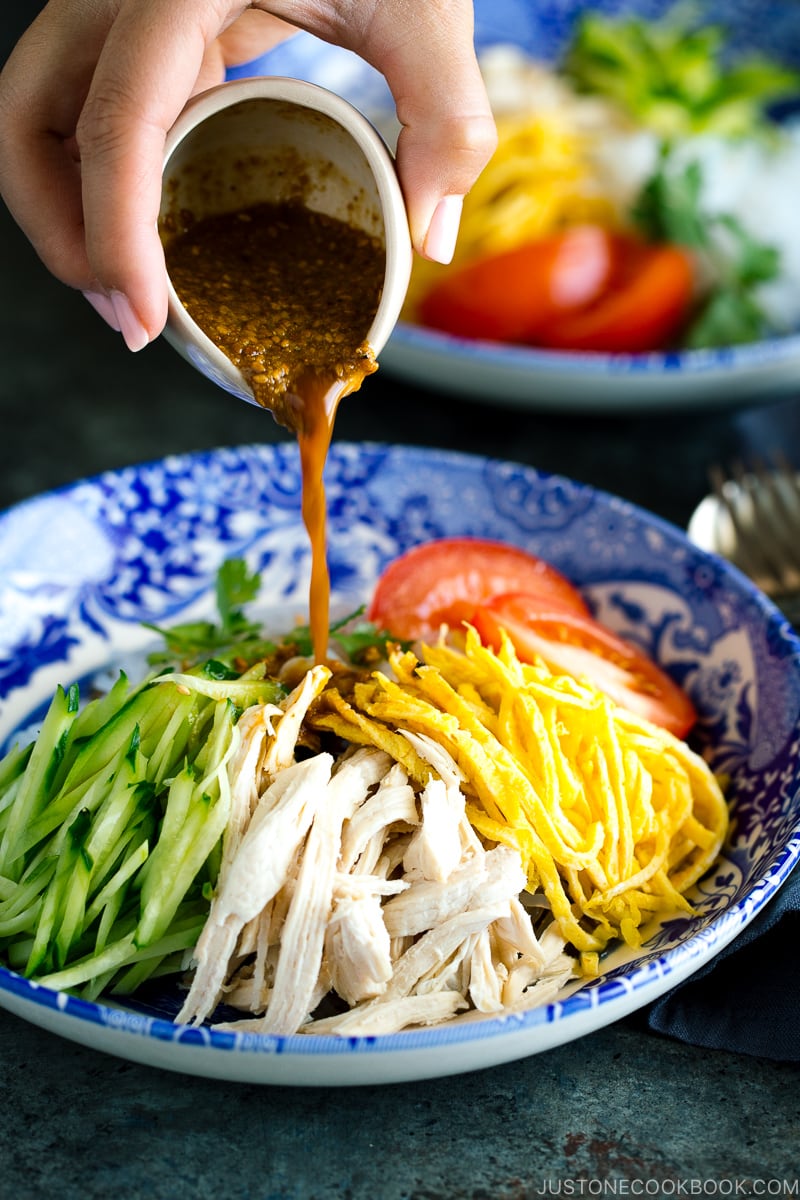
Tackle Shirataki Noodles’ Funky Smell
Let’s face the fact. Shirataki noodles are packaged in an awful-smelling liquid. Even though I am not bothered by this at all, I know some of you might. It is actually just water, but it has absorbed the odor from the konjac root. It didn’t go bad, so don’t throw it away.
It’s important to rinse them very well under cold running water and then cook in boiling water for about 2 minutes. This should remove most of the unpleasant odor.
On a side note, unlike pasta or Asian-style noodles, shirataki noodles have no starch. Therefore, after boiling they do not stick together. You can prepare them ahead of time without worrying about noodles becoming one big mess.
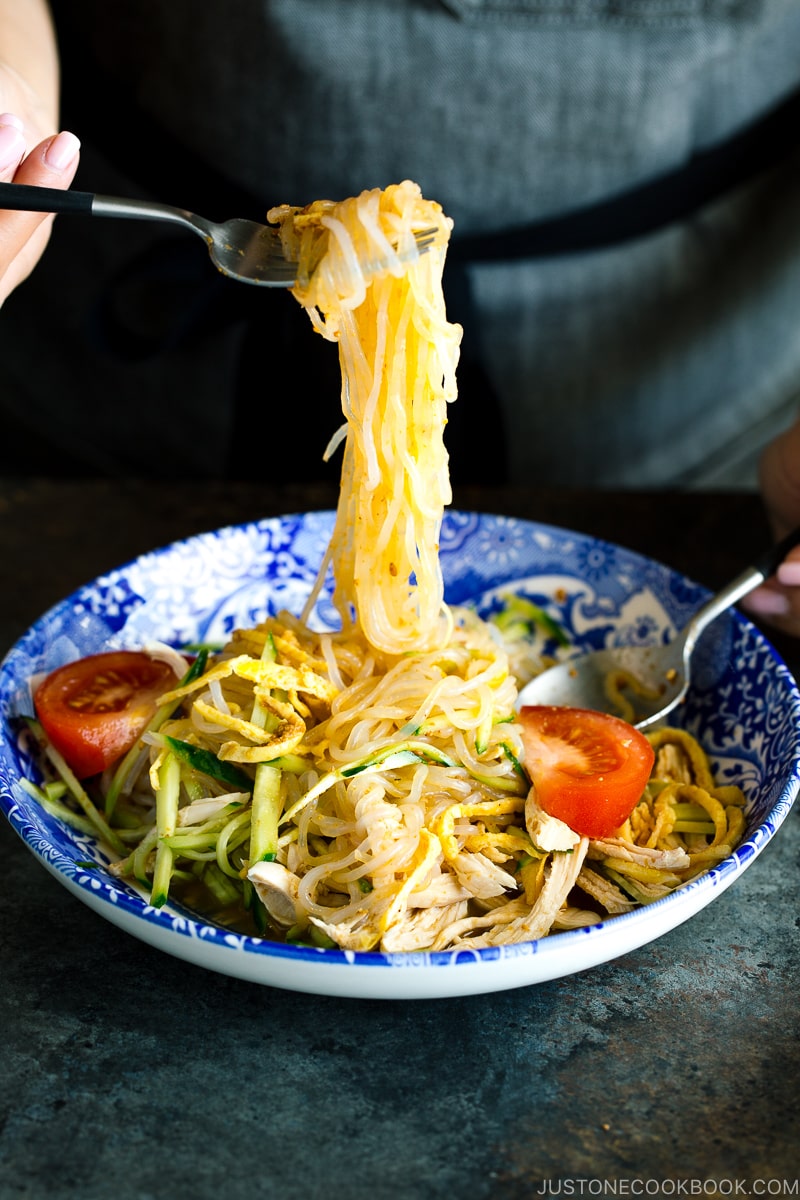
Delicious Honey Sesame Sauce
I mentioned earlier that shirataki noodles are flavorless but absorb many flavors from the sauce. So for this recipe, I made my Honey Sesame Sauce as it goes well with the noodles and toppings that I chose. If you have tried Japanese cold ramen called Hiyashi Chuka, this recipe is a variation of that dish. Hiyashi Chuka is a popular summer meal in Japan, and this recipe is a lighter version of it.
Fun Fact: Shirataki Noodles vs. Ito Konnyaku
Shirataki noodles are called Shirataki in eastern Japan (Tokyo area), and Ito Konnyaku (糸こんにゃく) in western Japan (Osaka area). The name difference is a result of different manufacturing methods.
In the past, ito konnyaku was prepared by cutting konnyaku jelly into threads, while shirataki is made by forcing konnyaku through small holes to get the shape.
Nowadays, both are prepared using the shirataki method but the packages keep the different names in each region. Ito konnyaku is generally thicker than shirataki, with a square cross-section and a darker color.

Wish to learn more about Japanese cooking? Sign up for our free newsletter to receive cooking tips & recipe updates! And stay in touch with me on Facebook, Pinterest, YouTube, and Instagram.
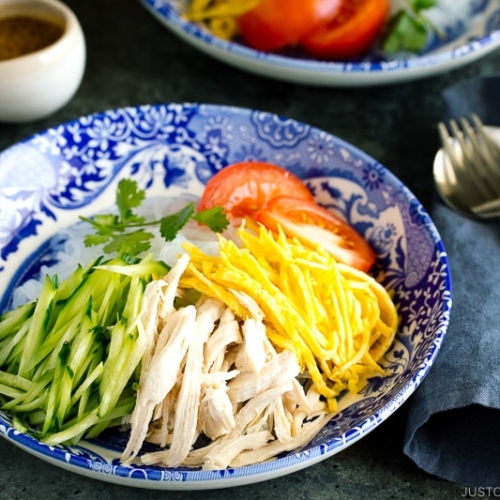
Honey Sesame Shirataki Noodles
Video
Ingredients
For the Chicken
- 4 cups water (for boiling)
- ½ tsp Diamond Crystal kosher salt
- 2 Tbsp sake
- 2 green onions/scallions
- 1 knob ginger (1 inch, 2.5 cm)
- 1 boneless, skinless chicken breast (12 oz, 342 g)
For the Honey Sesame Sauce
- 4 Tbsp toasted white sesame seeds
- 2 Tbsp honey
- 4 Tbsp rice vinegar (unseasoned)
- 2 Tbsp soy sauce
- 2 tsp toasted sesame oil
- ⅛ tsp freshly ground black pepper
For the Toppings
- 1 large egg (50 g each w/o shell)
- ¼ tsp Diamond Crystal kosher salt
- ½ Tbsp neutral oil
- 1 Japanese or Persian cucumber
- 1 tomato
- 1 sprig cilantro (coriander)
For the Shirataki Noodles
- 4 cups water (for boiling)
- 2 packages shirataki noodles (14 oz, 400 g)
Instructions
- Gather all the ingredients.

To Prepare the Chicken
- In a large pot, add 4 cups water, ½ tsp Diamond Crystal kosher salt, and 2 Tbsp sake. Bring it to a boil.

- Cut 2 green onions/scallions into thirds and cut 1 knob ginger into thin slices (you can keep the peel on). Add them to the pot.

- Butterfly 1 boneless, skinless chicken breast by cutting the length of the side of the chicken breast with the edge of your knife parallel to the cutting board. Carefully slice the breast in half widthwise until the other edge. Now you have two pieces of chicken breast.

- Once the water is boiling, put the chicken in the pot. Cover the lid and reduce the heat to the lowest setting. Cook the chicken for 15 minutes, or until cooked through.

- After cooking the chicken for 15 minutes, transfer it from the pot to a plate. Cover with plastic wrap to keep the moisture and let it cool.

To Prepare the Honey Sesame Sauce
- Heat 4 Tbsp toasted white sesame seeds in a dry frying pan (without oil) until fragrant; it will take 3–5 minutes, depending on the heat. Swirl the pan once in a while to rotate the seeds.

- Transfer the toasted sesame seeds into your Japanese mortar and pestle. You don’t have to completely grind the sesame seeds. To add texture to the dressing, it’s nice to keep both powdered and whole sesame seeds. If you don’t have a Japanese mortar and pestle, you can use a food processor.

- Transfer the ground sesame seeds into a 2-cup measuring cup. Add 2 Tbsp honey, 4 Tbsp rice vinegar (unseasoned), 2 Tbsp soy sauce, 2 tsp toasted sesame oil, and ⅛ tsp freshly ground black pepper. Whisk it all together and set aside.

To Prepare the Toppings
- Crack 1 large egg (50 g each w/o shell) in a medium bowl and whisk well. Add ¼ tsp Diamond Crystal kosher salt and combine well.

- Heat ½ Tbsp neutral oil in a nonstick frying pan over medium-high heat. Once the frying pan is hot, add the egg mixture. Turn down the heat to low and swirl the pan to evenly distribute the egg in the pan. Once the egg mixture is set, you can flip to cook the other side (optional) or continue to cook longer until the egg is cooked through. Turn off the heat and transfer the egg crepe to your work surface.

- Cut the egg crepe in half and thinly slice it. Set aside.

- Peel 1 Japanese or Persian cucumber but leave some skin unpeeled for a striped pattern (it looks better this way). Cut the cucumber diagonally into ⅛-inch (3-mm) slices. Then, cut it into thin long sticks. Set aside.

- Cut 1 tomato in half and cut each half into 3–4 wedges. Set aside.

- Shred the chicken into thin, long strips. When the ingredients are all the same shape, it’s easier to combine with the noodles and you can eat all the ingredients together.

To Prepare the Shirataki Noodles
- Boil 4 cups water in a saucepan. Tip: Boiling the shirataki noodles helps remove their unwanted odor, so don’t skip this step.

- Open 2 packages shirataki noodles and drain. Rinse quickly under cold running water.

- Once the water is boiling, add the shirataki noodles and cook for 2 minutes. Drain immediately and soak in an ice bath.

To Assemble the Noodles
- When the shirataki noodles are cold, drain well. On a plate, serve the shirataki noodles and toppings of your choice. Garnish with 1 sprig cilantro (coriander) and drizzle the dressing on top.

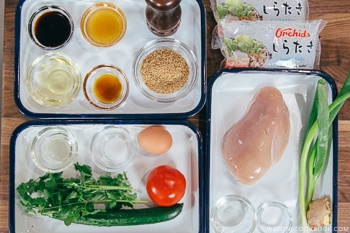
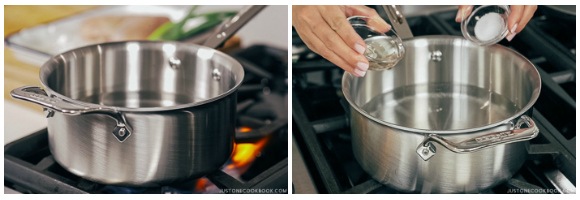

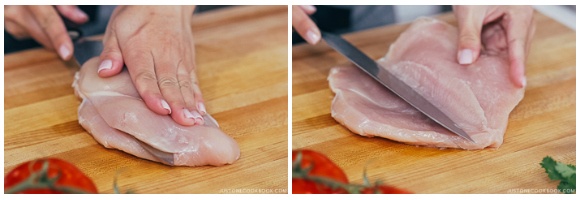

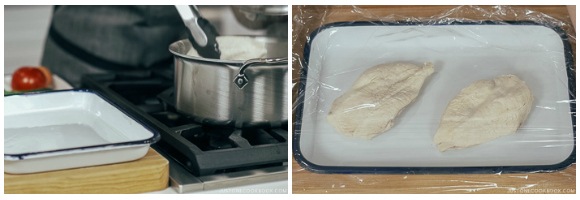
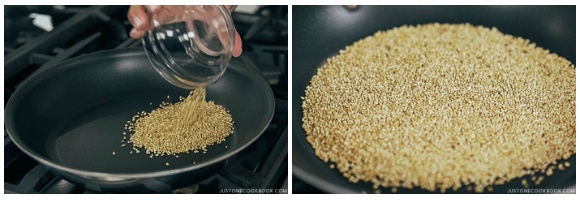
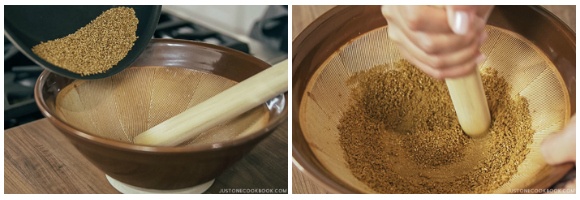

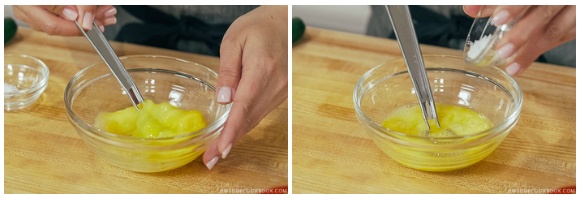

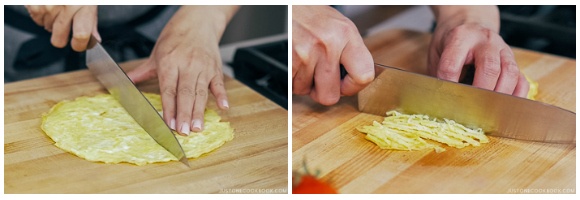

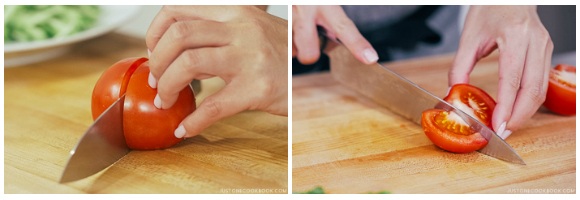
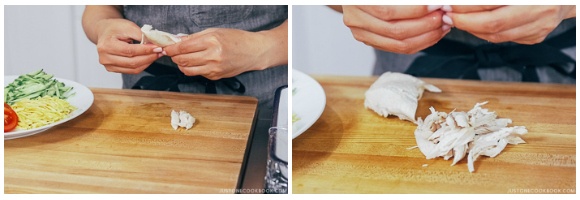
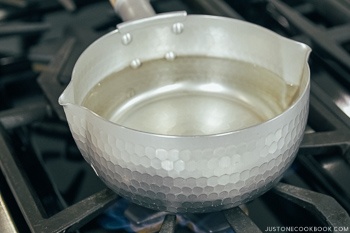

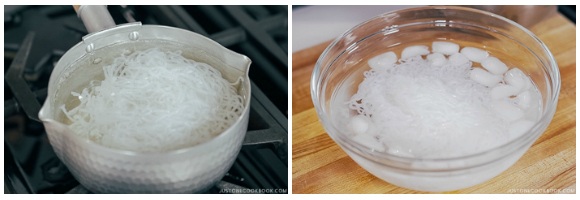
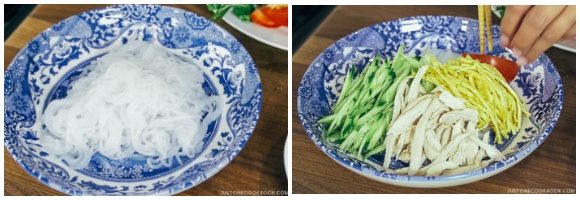











Made this today! Looks so pretty! Thank you as always!
Hi Olga! Thank you very much for trying Nami’s recipe and for your kind feedback!
We are so happy to hear it tuned out well.
Happy Cooking!❤️
Hi Nami, does this receipe keep well overnight? I’m looking to prepare this meal a day in advance and put it in the fridge until lunch the next day. Thanks!
Hi b c, Thank you very much for trying Nami’s recipe!
The Shirataki noodles get harder and lose their texture without the water/liquid, so we don’t recommend assembling ahead of time. If it’s for the next day, you can leave the Shirataki noodles in the water (Step 3) and place them in the refrigerator. Then at lunchtime, take it out and drain the water and assemble the dish.
We hope this helps!
Hello! Can I use buckwheat noodles instead?
Hi Rizza! Sure! Please feel free to adjust the amount of sauce you use over the noodle.
Thank you very much for trying Nami’s recipe!
Had some balance ham n tamagoyaki. Satisfied my midnight hunger ! Luv your recipes namiko chan ~~
Hi Yuzu! WOW! What a beautiful color of your Honey Sesame Shirataki Noodles!
Thank you very much for trying Nami’s recipe and sharing your experience and photo with us. We love it!🤩
hi Nami
can I substitute shirataki noodles in this recipe by harusame?
thanks
Hi Claudia! Thank you very much for reading Nami’s post!
Yes, Harusame should be fine. We hope you enjoy this recipe.🙂
WOW this recipe looks OUTSTANDING. Using Shirataki Noodles with Honey Sesame Dressing, especially in the summer is PERFECT. Yummie
Hi Ruth! Thank you very much for trying Nami’s recipe!
We are so happy to hear you enjoyed this dish! Thank you for your kind feedback.😊
Hi Nami,
Thanks for this delicious recipe. It’s hot today so I made this delicious noodle. Super easy to make and おいしいかった 🤤. I used wonder cherry tomatoes from Wholefood to make the topping more colorful and yuzu soysauce cuz I like soysauce. Thanks again for this easy recipe 😁
Hi Bamboo! Wow!🤩 Nice picture!🥰 We LOVE it!
Thank you very much for trying Nami’s recipe and for your kind feedback. Nami and JOC team are so happy to hear you enjoyed this noodle!
Hi Nami-san!!!
I have been using your website since I lived in America, and I love all your recipes. I had a question about this one. After boiling the chicken, can you use that water to boil the noodles? You had mentioned that the noodles take in flavor, so would it stand to reason that the flavors from the water (sake, onion, and ginger) would transfer to the noodles? In Japan, is this done? I ask not only as a cook but as someone who would like to go to Japan to teach one day.
Hi Grace! Thank you very much for using the JOC website!!!
Nami and JOC team are so happy to hear you enjoy many recipes from our site.
Yes, the Japanese reuse the water too. You may use the cooked water for noodles or make another type of soup. Just make sure to skim off the scum and fat from cooked water. https://www.justonecookbook.com/how-to-skim-off-the-scum-and-fat-from-soups-and-stocks/
We hope this helps!
Hello JOC, Ive been following and making your amazing recipes. You do such a GREAT job, specially with images and videos, Thank you so much!
would you be able to suggest a way to digitally save, other than pinterest, all these fabulous recipes? I’m looking for a platform where I could save and organize recipes from different sources (e.g if I have a picture of a recipe or a magazine cut out, etc)
Also, if you might be able to suggest a good online source for Japanese / Asian ingredients and kitchen tools. I was looking, I could not find the Yuzunomura Ponzu sauce that you love.
Thank you!
Hi jessb_it! Thank you so much for trying my recipes!
The problem of the online digital apps that can store online recipes is that they store our content. Our business is based on traffic coming to our site, so unless you make your own app (which is expensive to build and maintain) it’s very hard for us to accept. We’ve been talking about “save” function on our site with our developer and we’ll see how that would go. We’ve been working hard to make the search and filter function to help the readers get the recipes they are looking for.
I’m not very familiar with online Japanese grocery shops mostly because there is none that’s comprehensive than Amazon. Most Japanese products are imported and I can purchase in Japanese grocery stores here but they are not available. I’m sorry I am using Japanese brands but it’s just the taste that I’m familiar with… I’ve been working on Pantry pages and I’ll try to add more information on products and if I find online sources I’ll add to the pantry pages. 🙂
Thank you Nami.
Hopefully JOC will have its own save button soon!
Under regular circumstances, I have access to Asian grocery stores. Until life gets back to normal, I will continue to order online…..
No need to apologize for using Japanese brands, they are a must to create authentic good quality recipes. We should always try to use original products!
Hi Jessb_it! Thank you for understanding! We have a long list of fixing and improvements for the website, and saving function is included. 🙂 This current circumstance hopefully pushed some Asian/Japanese grocery stores to think about online shops… I can’t wait for the day when everyone has an easy access to Asian/Japanese ingredients worldwide. 🙂
[…] dressing from Happy Body Formula Shirataki noodles with almond butter sauce from Wallflower Kitchen Honey sesame shirataki noodles from Just One Cookbook Paleo Pad Thai from Fresh Planet […]
[…] Honey sesame shirataki noodles from Just One […]
[…] Honey sesame shirataki noodles from Just One Cookbook […]
[…] Honey sesame shirataki noodles from Just One Cookbook […]
This was the best!!! I can’t wait for warmer weather to enjoy this more! I added random vegetables by boiling them and chilling before serving.
Hi Jane! Thank you so much for trying this recipe! So glad you enjoyed this recipe. Yes, it would be nice to serve in hot summer weather. 🙂